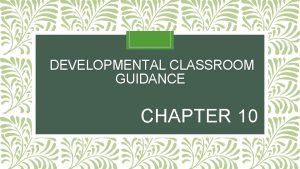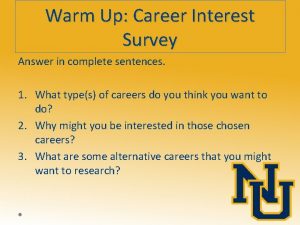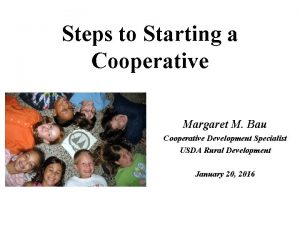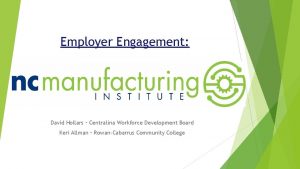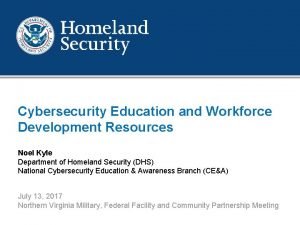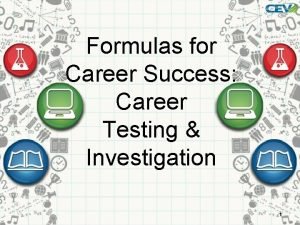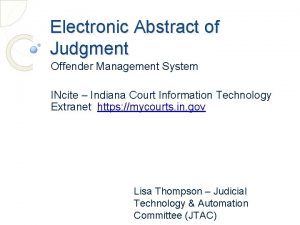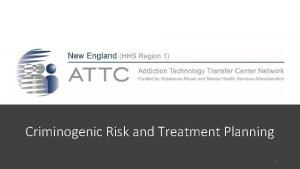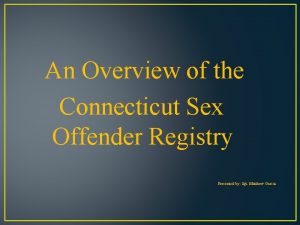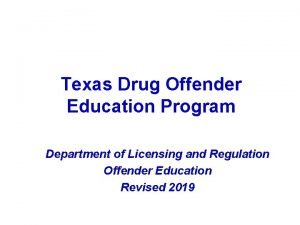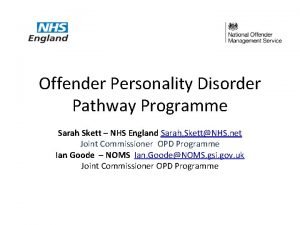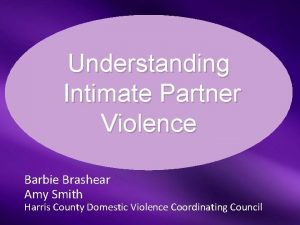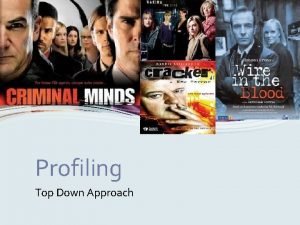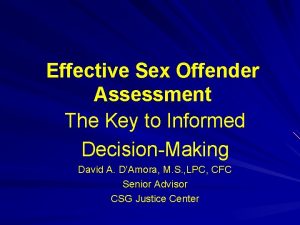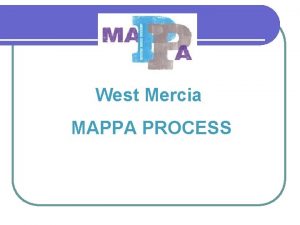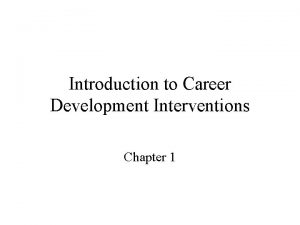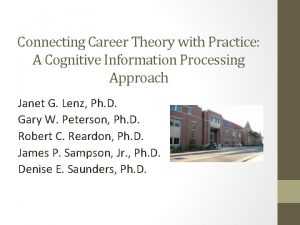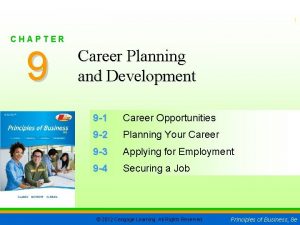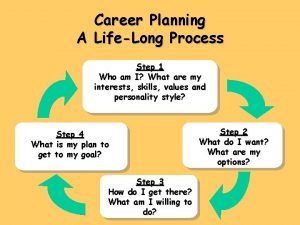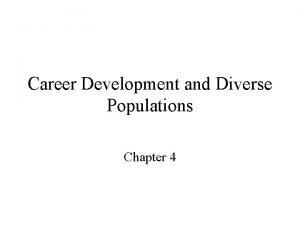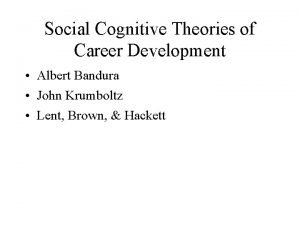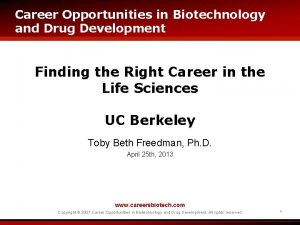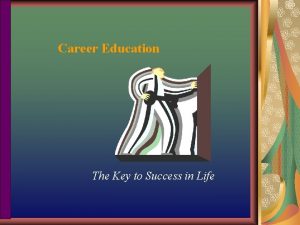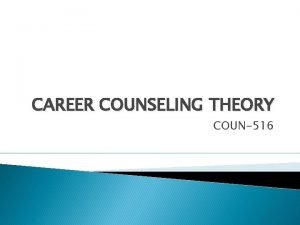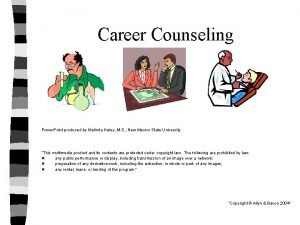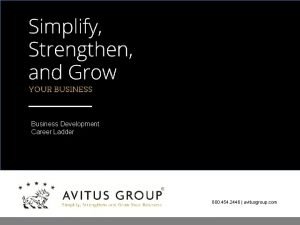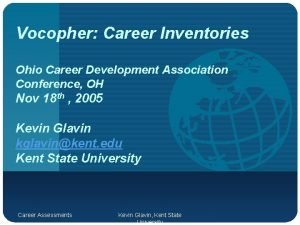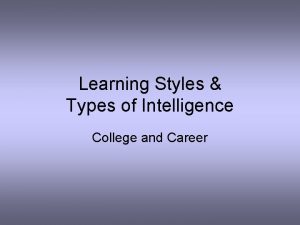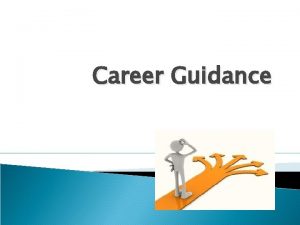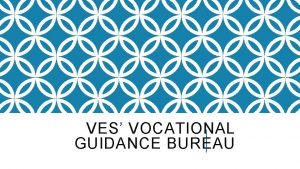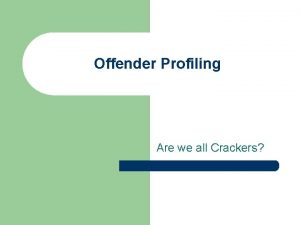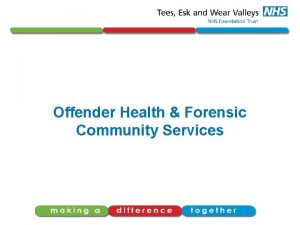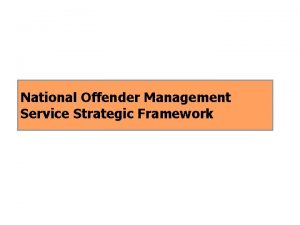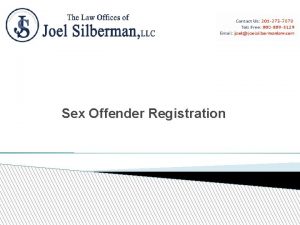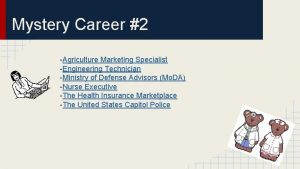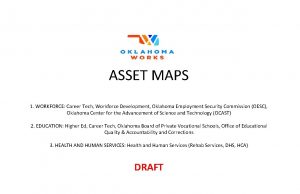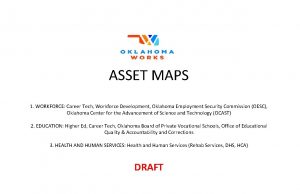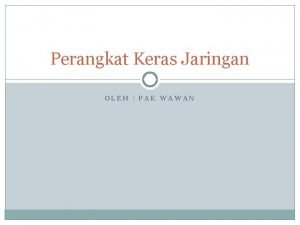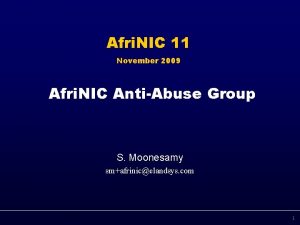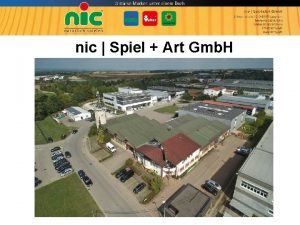Career Guidance Technician NIC Offender Workforce Development Specialist


























































- Slides: 58

Career Guidance Technician NIC Offender Workforce Development Specialist JOBS FOR A SAFER GEORGIA

A new Initiative developed by the Federal Bureau of Prisons • GDC Career Centers. • Career Guidance Technicians.

What is a GDC Career Center? • A place where career exploration is conducted. • Trained inmate technicians provide assistance to other offenders using interest assessments & career decision making materials. • Technicians are under staff supervision.

Who are the participants? • Inmates who are within 24 -36 months of release. • Inmates who are planning to seek employment.

How does it work? • Staffed by Career Guidance Technicians and coordinated by GDC Counselors. • Inmates will complete the INTEREST PROFILER, a free occupational assessment available through DOL. • Inmate peer groups will be conducted by aides to facilitate career exploration activities, ie. Mavis Beacon and resumes. • Inmate participants will develop a career plan.

How does it work? (Continuation) • Prior to release, Counselor makes personal contact with DOL TOPPSTEP representative. • After release, Inmate makes personal contact with DOL TOPPSTEP representative.

What are the benefits? • Statewide DOL TOPPSTEP staff are trained and prepared to assist Offenders locate employment and other services when the Offender returns to the community. • GDC, DOL, Parole and the Technical College are partners in this initiative. • Enhanced job placement, retention and satisfaction.

Everyone Benefits!!! • Statistics show recidivism is lowered 1 % per day for each day employed during the first 30 days of release.

How do we establish Career Centers? • Training – staff – inmates • Inmate Peer Groups • Identify location and have required NIC Career Center materials.

Where do we go from here? • First, Career Guidance Technicians begin to implement INTEREST PROFILER. • Second, Career Guidance Technicians assist participants to prepare a career plan. HERES HOW!!!!

O*net interest profiler Instrument

Completing the INTEREST Profiler • Use the Interest Profiler Booklet. • Use the Interest Profiler Score Report.

TRY NOT TO THINK ABOUT • Whether you have enough education or training to perform the activity, or • How much money you would make performing the activity.

REMEMBER • THIS IS NOT A TEST ! • THERE IS NO TIME LIMIT.

MARKING YOUR ANSWERS • L = Like • D = Dislike • ? = Unsure • Try not to have too many ? • Your first impulse answer is probably the right answer to use.

MARKING YOUR ANSWERS • Always work down the columns before proceeding to the next column. • Answer Questions 1 through 12 before proceeding to Question 13.

When you have completed page 7, please STOP. • We will score the interest profiler in the workshop. • You should not take more than about 15 minutes to complete the instrument.

Questions ? ? ? ? ?

NEXT! Scoring the Interest Profiler? ? ?

SCORING THE INSTRUMENT • Count the number of likes (L) for both rows of green questions on pages 4 and 5. Place the total in the top green box on the fold out. • Count the number of likes (L) for both rows of green questions on pages 6 and 7. Place the total in the bottom green box. • Add these & place in the white box.

SCORING CONTINUATION • Do the same for the pink, orange, purple, yellow and blue boxes. • When you have finished this, STOP and stand up at your seat.

PLEASE BE SEATED • Find your interest profiler Score Report and open it up to page 1. • Transfer your scores from the interest profiler Instrument to page 1 of the Score Report.

SCORING • Transfer your highest R-I-A-S-E-C score from page 1 to page 2 under the Primary Interest Area section at the top left of the page. • If 2 areas are tied or within 5 points of each other use both for your primary interest area. You have 2 equally strong interests.

SECONDARY INTEREST AREAS • Put your next two highest scores in the Secondary Interest Areas on page 2. • Use Secondary Interest Areas if you don’t find enough occupations to explore on your Primary Interest Area

Holland’s Theory • Individuals have unique characteristics. • Occupations have unique characteristics. • These characteristics can be measured and matched together. • People function best in work environments compatible with their personalities.

REALISTIC • Practical • Hands on problems & solutions • Like plants and animals • Enjoy working with wood, tools and machinery • Enjoy working outdoors • Dislike jobs which mainly involve doing paperwork or working closely with others.

INVESTIGATIVE • Like to work with ideas • Like to think rather than do physical activity • Like to research facts • Like to figure out problems mentally rather than to persuade or lead people.

ARTISTIC • Like forms • Like designs • Like patterns • Like self expression in their work • Prefer work settings where work can be done without a clear set of rules

SOCIAL • Like to assist others • Like to promote learning and personal development • Prefer communication to working with objects, machines or data • Like to teach, to give advice, to help or otherwise to be of service to people

ENTERPRISING • Like to start up & carry out projects • Especially enjoy business ventures • Like to persuade and lead people • Like to make decisions • Like to take risks for profit • Prefer action to thought

CONVENTIONAL • Like to follow set procedures and routines • Prefer working with data and detail rather than ideas • Prefer precise standards to work rather than having to judge yourself • Like working where lines of authority are clear

The Six Personality Types

JOB ZONES • ZONE 1 • ZONE 2 • ZONE 3 • ZONE 4 • ZONE 5 • Little or No preparation • Some preparation • Medium preparation • Considerable preparation • Extensive preparation

OCCUPATIONS • Turn to pages 12 thru 23 according to your Primary Interest area • Go to the Job Zone that you selected to investigate. • Select one or more occupations which you wish to explore • Make a note of the O*NET SOC Title and O*NET SOC #

OCCUPATIONAL OUTLOOK HANDBOOK (OOH) • O*NET SOC Titles and SOC #s are listed with extensive information on each Title. • Let’s select an occupation and look at the entry in your Occupational Outlook Handbook.

QUESTIONS • ? ? ? ? ? ? ?

Develop a Career Plan using the 7 Steps of Career Planning – The career planning process is circular – Each step may be repeated several times in a person’s life and people go back and forth between steps. 1 Become aware 2 Take a snap shot 3 Identify Job 7. GET A JOB! 6 Get education And or Training 5 Choose Alternative jobs 4 Get info About job

Developing a Career Plan (continued) • Step 1 – Become aware of need to make a choice. • Step 2 – Take a snapshot of yourself. – At this step, individuals need to learn about themselves – especially their interests, skills, and work values – in order to relate these to possible occupations.

Developing a Career Plan (continued) • Step 3 –Identify occupational alternatives. – At this step, individuals need to find some occupations that are related to their interests, skills, and/or work values and that may be realistic choices.

Developing a Career Plan (continued) • Step 4: Get information about identified alternatives – Obtain recent, accurate information about the occupations being considered.

Developing a Career Plan (continued) • Step 5: Choose among alternatives – Compare and contrast the occupations and put them in rank order. • may include selecting an occupation for first entry and others to pursue at a later time when more education and experience are gained.

Developing a Career Plan (continued) • Career Guidance Technicians can be very helpful – by assisting offenders to note the differences between the various options. – Get any kind of closer-to-life experience with prison work tasks. • work assignments while in prison that are similar to the tasks of occupations on the list • Interviewing people in those occupations at job fairs.

Developing a Career Plan (continued) • Step 6: Get the required education and training • Step 7: Get a job.

Developing a Career Plan (continued) TO BEGIN THE CAREER PLAN • Use results of INTEREST PROFILER. • Determine career path • Develop a Retention Plan – Identify potential problems – Minimize risks – Focus on strengths

Developing a Career Plan (continued) • Establish a Contingency Plan – Crisis planning – Identify Job Loss Indicators • Advancement Planning – Set employment goals – Create plan to achieve short and long term goals

DOL & Employment Workshops • Developing Department of Labor TOPPSTEP resources before release from prison. • Learning skills needed to find a good job quickly, i. e. . Resume, Mock Interviews, Dress for Success.

Internet Job Search Internet Sites for Career Planning • COOL (College Opportunities On. Line) – sponsored by the National Center for Educational Statistics • Provides a national searchable database of all kinds of schools – four-year colleges, two-year colleges, and vocational-technical schools. – Gives information about each school – includes a link to the home page of each institution for additional information

Internet Sites for Career Planning (cont) • The RWM Database – national searchable database of vocational/ technical schools • Department of Education – www. ed. gov/prog_info/SFA/Student. Guide – Financial Aid site • Provides information about federal scholarship and loan programs • Online FAFSA - form to receive financial aid.

Internet Sites for Career Planning (cont) Sites to: Get a job • • America’s Job Bank – www. ajb. org Richard Bolles’ Site – www. jobhuntersbible. com Riley Guide – www. rileyguide. com Monster – www. monster. comus

Internet Sites for Career Planning (cont) • America’s Job Bank – Listing of a million jobs updated nightly – Job-seekers can place their resumes in the Talent Bank by completing a questionnaire • List your e-mail address - system will automatically notify when a job meeting your characteristics is placed in database. – Employers can search this talent bank. Job seekers can, and the

Internet Sites for Career Planning (cont) • Richard Bolles’ Site – Bolles, author of the famous What Color is Your Parachute? maintains a site that provides original information, and links to a large number of sites • The Riley Guide – links to hundreds of sources for job leads, career exploration, and potential employers. Includes information on exploring new careers, finding places to live, and training and education options

Internet Sites for Career Planning (cont) • Monster. com – allows users to post resume – search a large database of job openings – get career advice.

Internet Sites for Career Planning (cont) America’s Career Info. Net (http: //www. acinet. org) • • • · Explore Options for Work and Learning · Gain Skills to Get a Job or Get a Better Job · Find Financial Assistance · Find Job-Search Resources and Services · Find Possible Jobs and Employers · View Career Videos on 200 selected occupations

Internet Sites for Career Planning (cont) Sites for information about alternatives • Occupational Outlook Handbook – www. bls. gov/oco • Career. Info. Net – www. acinet. org • O*Net – http: //online. onetcenter. org • COOL – http: //nces. ed. gov/ipeds/cool • RWM Database – www. rwm. org/rwm • Department of Education – www. ed. gov/prog_info/SFA/Student. Guide

Internet Sites for Career Planning (cont) • Many Other Sites – there are many other sites that can assist offenders to find housing, onestop centers, and to engage in e-mail networking.

What are the challenges? • Need staff support and coordination to supervise inmates working with other inmates. • Tracking offenders. • Time staff devotes to training.

What are the desired results? • Reduced recidivism rates. • Enhanced public safety. • Motivated offender population. • Offender obtains his/her desired career.

Workforce Development Unit • Michelle Turpeau (404) 693 -0416 • Javonne Dalring (404) 617 -1589 • Phil Omdalh (478) 218 -3334
 Offender workforce development specialist
Offender workforce development specialist Once a sex offender always a sex offender
Once a sex offender always a sex offender Lmi4all
Lmi4all Developmental classroom guidance specialist as a counselor
Developmental classroom guidance specialist as a counselor Radar and sonar technician career cluster
Radar and sonar technician career cluster Condylar guidance and incisal guidance
Condylar guidance and incisal guidance Indirect skills
Indirect skills Margaret bau
Margaret bau Ecg career guidance
Ecg career guidance History of counseling in the philippines timeline
History of counseling in the philippines timeline Conceptualisatio
Conceptualisatio Proposal writing on career guidance workshop
Proposal writing on career guidance workshop Career guidance training
Career guidance training Proposal writing on career guidance workshop
Proposal writing on career guidance workshop Centralina workforce development board
Centralina workforce development board Golden sierra workforce development board
Golden sierra workforce development board Cybersecurity workforce development toolkit
Cybersecurity workforce development toolkit Virginia workforce development board
Virginia workforce development board Fcs lanchpad
Fcs lanchpad Formulas for career success career testing & investigation
Formulas for career success career testing & investigation Prashant chopra sex offender
Prashant chopra sex offender Sex offender evaluation illinois
Sex offender evaluation illinois Offender management system
Offender management system What are the 8 criminogenic needs
What are the 8 criminogenic needs Connecticut sex offender registry
Connecticut sex offender registry Thor directory
Thor directory Texas drug offender education program test answers
Texas drug offender education program test answers Offender personality disorder pathway
Offender personality disorder pathway A tyrannical offender:
A tyrannical offender: Yakama nation sex offender registry
Yakama nation sex offender registry Top down profiling
Top down profiling Interview sex offender
Interview sex offender [email protected]
[email protected] Minnesota sex offender screening tool
Minnesota sex offender screening tool Bottom up offender profiling
Bottom up offender profiling Typological profiling
Typological profiling Mappa offender
Mappa offender Olass - offender learning and skills service
Olass - offender learning and skills service Aura phase serial killer
Aura phase serial killer Ul guidance counselling
Ul guidance counselling Australian blueprint for career development
Australian blueprint for career development Mrc career development award
Mrc career development award Career development introduction
Career development introduction Qanxiety
Qanxiety Chapter 9 career planning and development
Chapter 9 career planning and development Career development is a lifelong process
Career development is a lifelong process Career development of diverse populations
Career development of diverse populations John krumboltz social learning theory
John krumboltz social learning theory Carey business school career development office
Carey business school career development office Career opportunities in biotechnology and drug development
Career opportunities in biotechnology and drug development Super's career development theory pros and cons
Super's career development theory pros and cons Career development plan by using graphic organizer
Career development plan by using graphic organizer Frank parson and williamson
Frank parson and williamson Donald super career development theory powerpoint
Donald super career development theory powerpoint What are the five stages of career development
What are the five stages of career development Business development career ladder
Business development career ladder Vocopher my career story
Vocopher my career story Hattie's barometer of influence
Hattie's barometer of influence Self smart careers
Self smart careers



